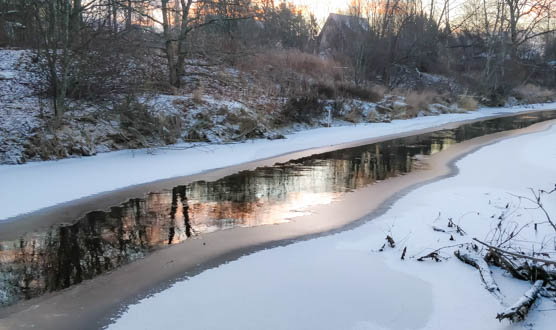
River Sestra. Photo: Petri Ekholm.
Of the three rivers examined by the SEVIRA project, the Sestra (р. Сестра) makes an especially interesting case, because there is no previous information of its water quality. The results from November 2018 – April 2019 indicate that the Sestra and Virojoki Rivers have lower total nitrogen concentration than the transboundary Seleznevka River (р. Селезневка). The average total nitrogen concentration in the upper and lower monitoring station of the Sestra was 560 and 940 µg/L, respectively, suggesting an increase in the loading towards the sea. In the Seleznёvka River, the average concentration varied between 3900 and 4400 µg/L by sites. The high nitrogen concentration in the Seleznevka is probably due to wastewaters from the city of Lappeenranta, Finland, and to a more intensive land use. Only 5% of the Sestra catchment is devoted to the agriculture, whereas almost 30% of upper part of the Seleznevka is under agricultural land use. In addition, forests occupy more of the land of the Sestra catchment than of the Seleznevka catchment.
The nitrogen level in the monitoring stations of the Seleznevka increased from November 2018 till February 2019. It is probably related to nitrogen input from the wastewater treatment plant and losses from agricultural areas, since no such increase in nitrogen took place in the Sestra. Low flow during winter and potential seasonal changes in wastewater nitrogen treatment efficiency may have had a role in the observed increase in the nitrogen level. The spring flow peak that occurred in March 2019 diluted nitrogen concentration of the Seleznevka River, a phenomenon typical of rivers loaded by point source effluents.
Although total phosphorus concentrations were also lower in the Sestra than in the Seleznevka, the difference here was smaller. The average total phosphorus concentration in the Sestra was 35–47 µg/L and 55–58 µg/L in the Seleznevka. During winter the phosphorus concentrations were sometimes the same in these rivers. There was no seasonal trend in phosphorus levels.
According to nitrogen and phosphorus concentrations, the Sestra appears to be in a satisfying condition and the Seleznevka in a bad ecological condition. The future sampling will shed more light on the state of these rivers and the factors responsible for it.
The SEVIRA project enables more intensive water quality sampling of three rivers entering into Gulf of Finland. All together nine river monitoring stations located in Russia and Finland are included in the study. The project team is sampling and analyzing the water quality during 2018–2021.
Total nitrogen concentration (µg/L)